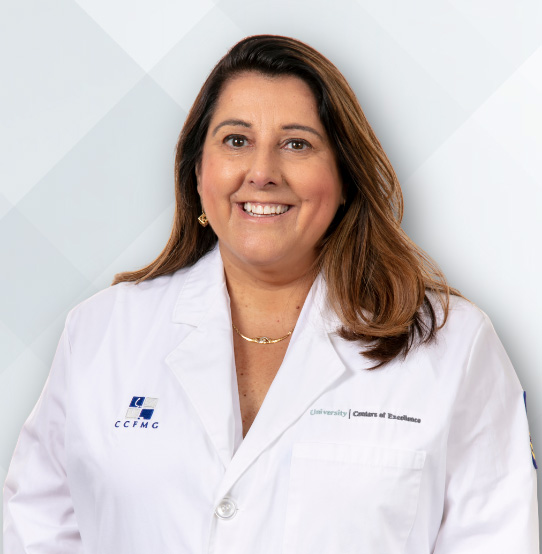Alicia Rodríguez-Pla, MD, PhD, MPH

Alicia Rodríguez-Pla, MD, PhD, MPH, is a clinical fellow in rheumatology at Boston University Medical Center. Dr. Rodríguez-Pla completed her VCRC Fellowship (2007-2009) at Johns Hopkins University, with Phil Seo, MD, MHS, as her mentor. Dr. Rodríguez-Pla is conducting clinical research with Dr. Paul Monach, MD, PhD, and collaborating with the VCRC on biomarker research projects.
This interview with Dr. Rodríguez-Pla was conducted by the Vasculitis Foundation, March 2007.
I grew up in the southeast of Spain, between Caudete, a small town in which I was born, and Alicante, a nearby Mediterranean tourist city. I am married and have a four-month-old baby son called Mark. My husband, José, is also a doctor who specializes in preventive medicine and public health.
I spend as much of my free time as possible with my husband and playing with my son. I like travelling and meeting people from different cultures. I love reading all kinds of books, especially novels, walking, swimming, going to the theater and getting together with friends. Although it may sound weird, studying and learning are my main hobbies.
I realized I wanted to become a doctor in high school. During those years I started to develop a great interest in health-related issues, primarily for helping people and for research, which I consider the basic tool for medical advances. And last but not least, decreasing the negative impact of diseases in people.
I received a scholarship which allowed me to attend medical school in a very prestigious private university called Universidad de Navarra, in Pamplona, a city in the north of Spain. After medical school I moved to Barcelona and enrolled in a fellowship program in rheumatology. Once completed, I worked on my Ph.D. thesis, where I studied several pathogenic and epidemiologic aspects of giant cell arteritis. It was shortly after defending my thesis in 2003 that I moved to the United States.
Very early in my career I became fascinated by vasculitis disorders. My first clinical rotation was in the Department of Cardiovascular Surgery in 1991, during my fourth year in medical school. I remember the first patient I visited in the hospital was a woman affected by Takayasu’s arteritis who had also developed retroperitoneal fibrosis. Never before had I heard that blood vessels could become inflamed. The faculty in charge asked me to review the literature to find out if a similar association between Takayasu’s arteritis and retroperitoneal fibrosis had previously been reported. I found only one case published in a Japanese journal, which was impossible for me to get at the time. The faculty then asked me to write a short review about Takayasu’s arteritis as an exercise. I remember how my interest and curiosity progressively increased while reviewing the literature and learning about this vasculitis. I typed a thirteen-page manuscript, which I still keep, on a classical typewriter. It was because of the interest that this patient woke up in me that I decided to become a rheumatologist.
I did not come across any other patients with vasculitis until January 1995, when I saw a second patient with Takayasu’s arteritis during my first month as a fellow in rheumatology. This was striking, taking into consideration that this type of vasculitis is quite rare in Spain. During the following months I saw patients with other vasculitic syndromes, including granulomatosis with polyangiitis (Wegener’s), eosinophilic granulomatosis with polyangiitis (Churg-Strauss), polyarteritis nodosa, and giant cell arteritis among others. I was amazed that a patient with giant cell arteritis, who had been completely blind for two days, recovered her vision right after starting prednisone treatment. Fortunately, she had been diagnosed and treated early.
As a curiosity, my father was the third patient I saw with giant cell arteritis and I participated actively in his diagnosis. In May 1996, at the age of 53, he started complaining of intense headaches, fatigue, and pain and weakness in the girdles. He was initially diagnosed with depression and treated for several months with antidepressant medication. He did not improve, and I suggested to his doctor the possibility of giant cell arteritis. Initially, he did not believe me because my father was too young to have this vasculitis, and I was too young to suggest anything. After almost six months, he finally decided to draw some blood, and the diagnosis then became quite obvious.
I would like to point out that my interest comprises all kinds of vasculitic syndromes and all vasculitis patients. I chose giant cell arteritis for my Ph.D. thesis simply because it is the most frequent type of vasculitis worldwide including Spain. I am convinced that the pathogenic mechanisms underlying the vascular and organ damage have certain similarities among the different vasculitic disorders, and that advances in knowledge of one of them could be quite easily extrapolated to others.
My PhD thesis included a project to study the potential role of different infectious agents in giant cell arteritis. At the American College of Rheumatology Annual Scientific Meeting in San Francisco in 2001, I saw that the group of physicians, including Dr. Stone from the Johns Hopkins Vasculitis Center were also interested in this field. Shortly after the meeting, I contacted Dr. Stone to ask about the possibility of joining his team to continue working on this research. Dr. Stone offered me a two-year fellowship at Johns Hopkins. Towards the end of these two years, my research interest had shifted and focused on understanding the molecular mechanisms underlying the vascular damage in the arterial wall in giant cell arteritis. It was at this point when the VCRC fellowship program was starting, and Dr. Stone mentored me to get into it.
My research is currently focused on better understanding the role of matrix metalloproteinases in giant cell arteritis. Matrix metalloproteinases are a group of enzymes capable of degrading varying components of the extracellular matrix in both normal and diseased tissue. They have been found to be associated with several vasculitic disorders. In concrete, I am working on two different laboratory projects. The first consists on characterizing the specific matrix metalloproteinases involved in vascular damage in giant cell arteritis. The second is a genetic study to determine if certain polymorphisms, that is, mutations, of metalloproteinase-9, a enzyme known to be involved in giant cell arteritis, are associated with this vasculitis.
One of the main things I have learned from my patients is to listen to them. Listening carefully to patients’ symptoms helps us to suspect a serious condition or relapse. Therefore, we may act quickly avoiding delays in treatment and, subsequently, preventing or diminishing complications.
I think that to be a better patient is essential to follow the physician’s indications. Of course, this should not be done “blindly” but rather in a “educated” manner. By this I mean that if a patient finds, for example, that a treatment is not working, call the doctor to discuss it with him/her. Another aspect would be by understanding that research is very important for advancing knowledge of the disease, and for developing new therapeutic options. An important challenge for doing investigation on vasculitis is the rarity of these disorders, which makes it difficult to get clinical samples for research purposes. By agreeing to participate in research projects whenever possible, patients can help to get better outcomes for themselves and others. Because most of the patients with vasculitis have chronic conditions, which require long-term follow-up, it is extremely important for them to engage in a good doctor-patient relationship. It is basic for them to find a physician they truly trust, and with whom they can communicate in a direct, open and honest way. They should take good care of themselves, attend regular follow-ups, and learn as much as they can about their diseases. The latter will help them to recognize promptly when they could be suffering from a relapse, which will lead them to look for the best medical care in every situation.
My main job duty is to do research in the laboratory setting. I am also a student in the part-time masters of public health program at the Johns Hopkins Bloomberg School of Public Health. So far, I have taken a series of courses in statistics and epidemiology, along with other required courses. I am currently taking a third series of courses on genetic epidemiology. I plan to graduate next May.
In addition, I have also been allowed to observe patients in The Johns Hopkins Vasculitis Center. During my stay at Johns Hopkins I have seen more patients affected by granulomatosis with polyangiitis (Wegener’s), eosinophilic granulomatosis with polyangiitis (Churg-Strauss), polyarteritis nodosa, and Takayasu’s arteritis than ever before. Unfortunately, for the last few months my lab work and classes in Public Health have made it impossible for me to attend the clinic.
I am very grateful to the VCRC for the opportunity it has provided me through this fellowship. My weekly visits to The Johns Hopkins Vasculitis Center clinic have offered me a unique opportunity to see a great variety of vasculitis patients, and some of them while going through challenging medical situations. This has greatly enhanced my clinical skills to manage patients with vasculitis. This fellowship has also helped me to increase my laboratory skills, and it has provided me with the opportunity of enrolling in an academic program in the form of a masters of public health in the worldwide prestigious Johns Hopkins Bloomberg School of Public Health. In addition, from the personal point of view, this experience has been also very fulfilling.
During my time at Johns Hopkins I would like to increase both my skills as a translational researcher and as a clinician. I think that the tridimensional approach of the training program I have been involved in during my stay here will help me to accomplish this goal. My bench work and the courses of the Master of Public Health program are providing me with essential tools to design and perform translational and epidemiologic investigations. In addition, the time I have spent in clinic has helped me to be a better and more skilled physician for my patients. By combining this training program, the detailed “picture” offered by the laboratory bench research, the patients observation in the clinical setting and the big “picture” provided by the epidemiology and public health perspective, I believe I can integrate a broad range of knowledge, that will overall and help me to be a better scientist.
Once I leave Johns Hopkins, I would like to continue working on vasculitis, and probably on other autoimmune and inflammatory disorders in Spain. I hope the skills I have acquired during my stay here will help me to earn a faculty position in Spain in where I can combine both, patient care and research. I would also like to participate in international projects in the future, which include collaboration among different countries.

